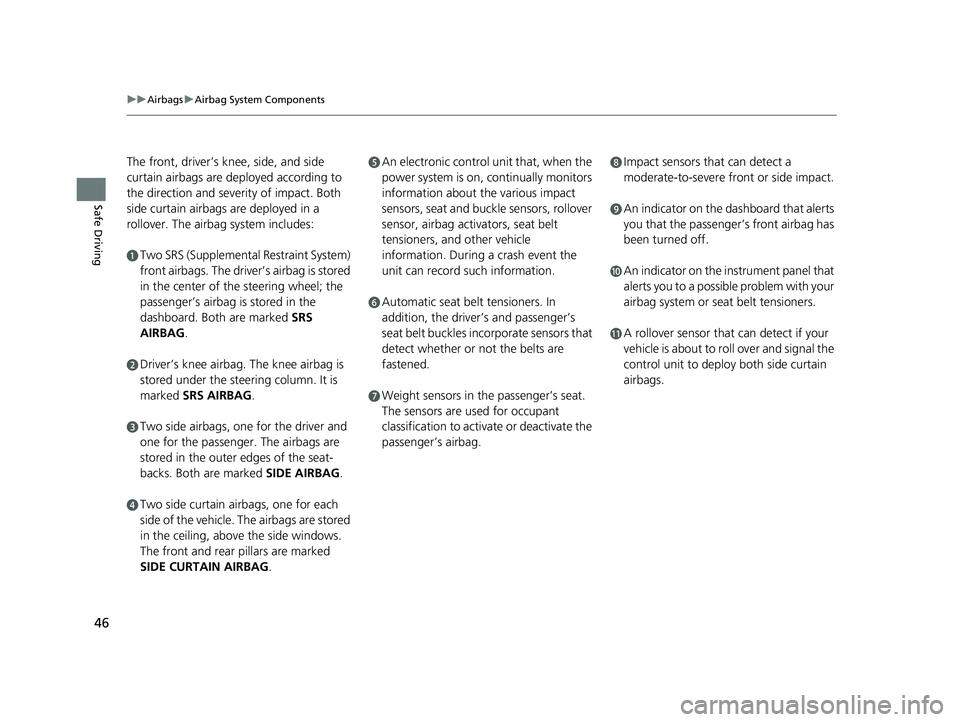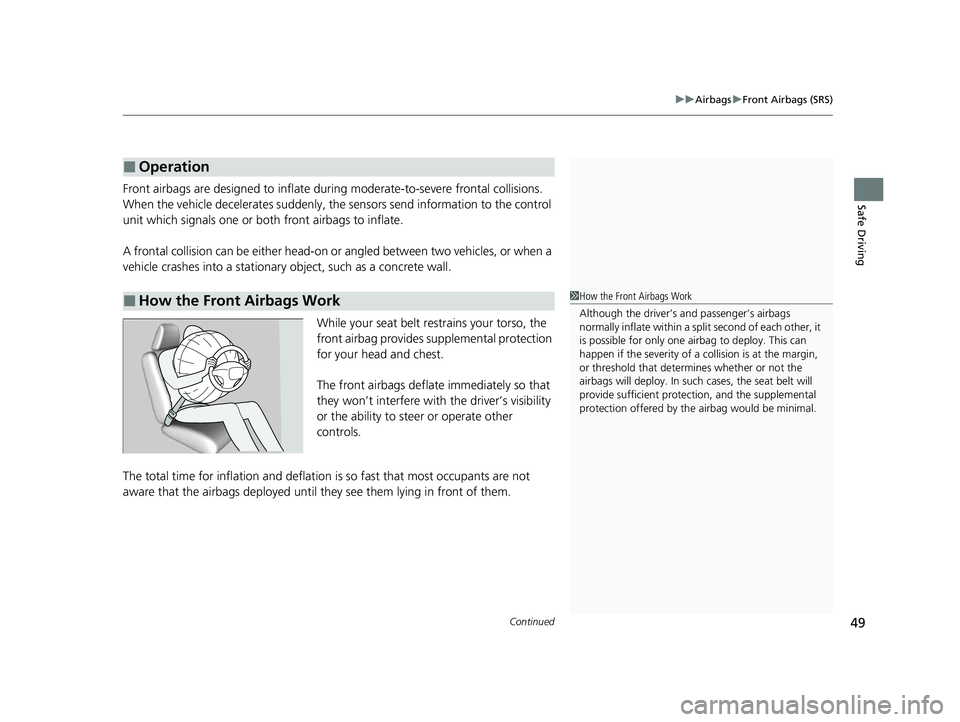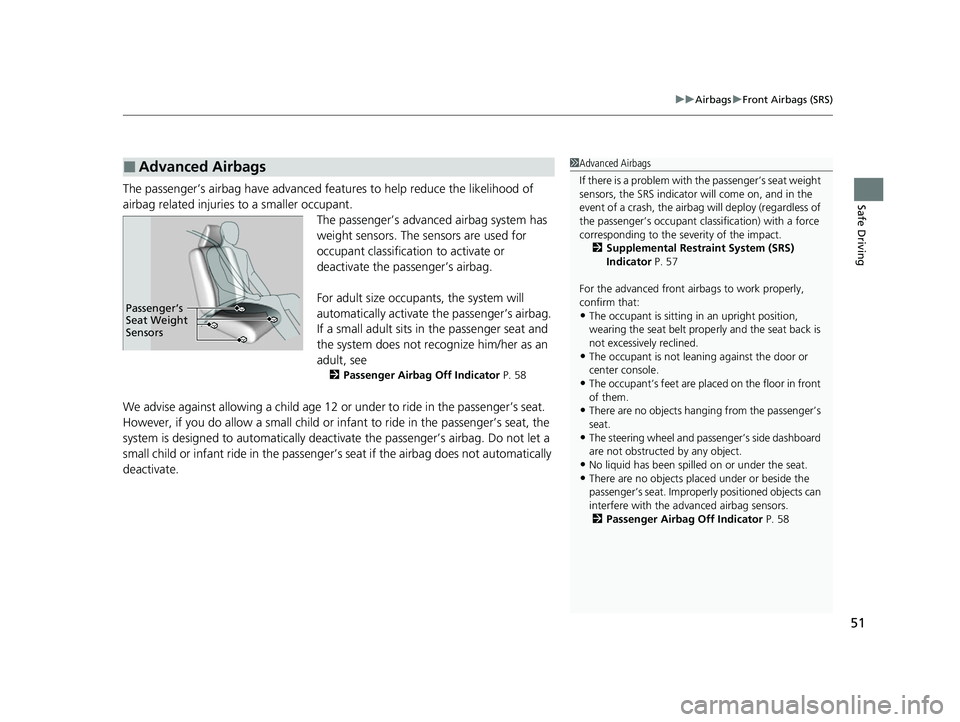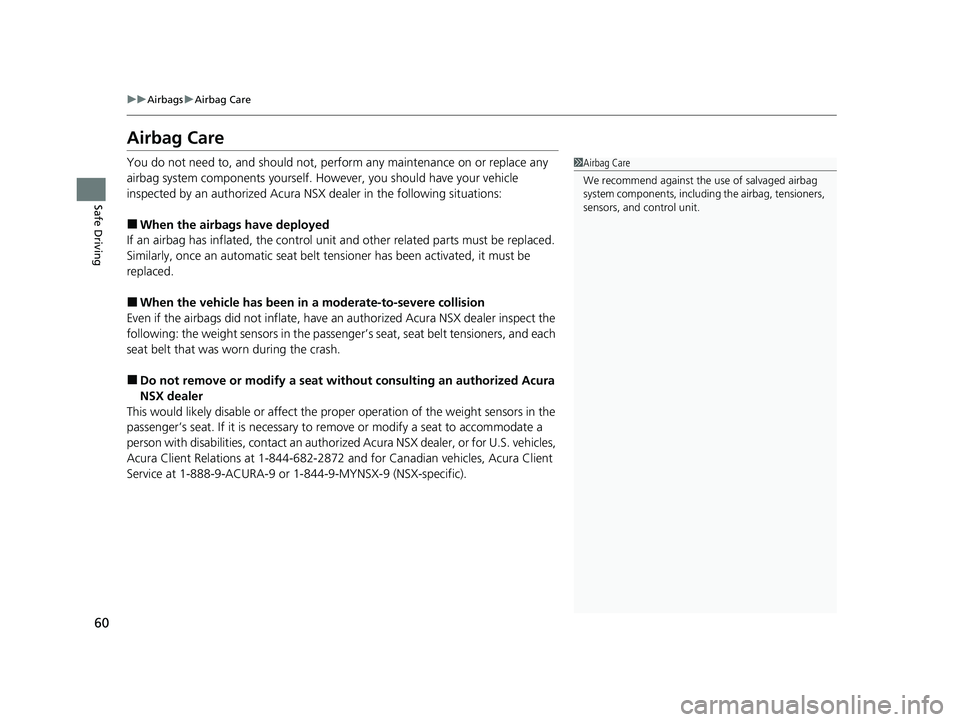sensor ACURA NSX 2021 Owners Manual
[x] Cancel search | Manufacturer: ACURA, Model Year: 2021, Model line: NSX, Model: ACURA NSX 2021Pages: 494, PDF Size: 16.57 MB
Page 8 of 494

6
Quick Reference Guide
Quick Reference Guide
Visual Index
❚Steering Wheel Adjustments (P 144)
❚ENGINE START/STOP Button (P 131)
❚ (Vehicle Stability AssistTM (VSA®)
System OFF) Button
(P 351)
❚System Indicators (P 74)
❚Gauges (P 99)
❚Driver Information Interface (P 102)
❚Rear Defogger/Heated Mirror Button
(P 140)
❚Parking Sensor System Button*
(P 370)
❚Hazard Warning Button
❚Seat Heater Buttons* (P 158)
❚Audio System (P 166)
❚Climate Control System (P 159)
❚MID Vents (P 22, 159)
❚Navigation System*
() See the Navigation System Manual
❚Integrated Dynamics System Mode
Switch
(P 340)
21 ACURA NSX PMC-31T6N6400.book 6 ページ 2020年10月8日 木曜日 午後3時7分
Page 48 of 494

46
uuAirbags uAirbag System Components
Safe Driving
The front, driver’s knee, side, and side
curtain airbags are deployed according to
the direction and severity of impact. Both
side curtain airbags are deployed in a
rollover. The airbag system includes:
aTwo SRS (Supplemental Restraint System)
front airbags. The driver’s airbag is stored
in the center of the steering wheel; the
passenger’s airbag is stored in the
dashboard. Both are marked SRS
AIRBAG.
bDriver’s knee airbag. The knee airbag is
stored under the steering column. It is
marked SRS AIRBAG.
cTwo side airbags, one for the driver and
one for the passenger. The airbags are
stored in the outer edges of the seat-
backs. Both are marked SIDE AIRBAG .
dTwo side curtain airbags, one for each
side of the vehicle. The airbags are stored
in the ceiling, above the side windows.
The front and rear pillars are marked
SIDE CURTAIN AIRBAG.
eAn electronic control unit that, when the
power system is on, continually monitors
information about the various impact
sensors, seat and buckle sensors, rollover
sensor, airbag activators, seat belt
tensioners, and other vehicle
information. During a crash event the
unit can record such information.
fAutomatic seat belt tensioners. In
addition, the driver’s and passenger’s
seat belt buckles incorporate sensors that
detect whether or not the belts are
fastened.
gWeight sensors in the passenger’s seat.
The sensors are used for occupant
classification to activate or deactivate the
passenger’s airbag.
hImpact sensors that can detect a
moderate-to-severe front or side impact.
iAn indicator on the dashboard that alerts
you that the passenger’s front airbag has
been turned off.
jAn indicator on the instrument panel that
alerts you to a possib le problem with your
airbag system or seat belt tensioners.
kA rollover sensor that can detect if your
vehicle is about to roll over and signal the
control unit to deploy both side curtain
airbags.
21 ACURA NSX PMC-31T6N6400.book 46 ページ 2020年10月8日 木曜日 午後3時7分
Page 51 of 494

Continued49
uuAirbags uFront Airbags (SRS)
Safe DrivingFront airbags are designed to inflate duri ng moderate-to-severe frontal collisions.
When the vehicle decelerates suddenly, the sensors send information to the control
unit which signals one or both front airbags to inflate.
A frontal collision can be either head-on or angled between two vehicles, or when a
vehicle crashes into a stationary object, such as a concrete wall.
While your seat belt restrains your torso, the
front airbag provides supplemental protection
for your head and chest.
The front airbags deflate immediately so that
they won’t interfere with the driver’s visibility
or the ability to steer or operate other
controls.
The total time for inflation and deflation is so fast that most occupants are not
aware that the airbags deployed until th ey see them lying in front of them.
■Operation
■How the Front Airbags Work1How the Front Airbags Work
Although the driver’s a nd passenger’s airbags
normally inflate within a spli t second of each other, it
is possible for only one airbag to deploy. This can
happen if the severity of a collision is at the margin,
or threshold that determines whether or not the
airbags will deploy. In such cases, the seat belt will
provide sufficient protec tion, and the supplemental
protection offered by the airbag would be minimal.
21 ACURA NSX PMC-31T6N6400.book 49 ページ 2020年10月8日 木曜日 午後3時7分
Page 52 of 494

50
uuAirbags uFront Airbags (SRS)
Safe Driving
■When front airbags should not deploy
Minor frontal crashes: Front airbags were designed to supplement seat belts and
help save lives, not to prevent minor scrape s, or even broken bones that might occur
during a less than moderate-to-severe frontal crash.
Side impacts: Front airbags can provide protection when a sudden deceleration
causes a driver or passenger to move towa rd the front of the vehicle. Side airbags
and side curtain airbags have been specifically designed to help reduce the severity
of injuries that can occur during a moderate-to-severe side impact which can cause
the driver or passenger to move toward the side of the vehicle.
Rear impacts: Head restraints and seat belts are your best protection during a rear
impact. Front airbags cannot provide any significant protection and are not designed
to deploy in such collisions.
Rollovers: In a rollover, your best form of protection is a seat belt or, if your vehicle
is equipped with a rollover sensor, both a se at belt and a side curtain airbag. Front
airbags, however, are not designed to deploy in a rollover as they would provide
little if any protection.
■When front airbags deploy with little or no visible damage
Because the airbag system senses sudden deceleration, a strong impact to the
vehicle framework or suspension might caus e one or more of the airbags to deploy.
Examples include running into a curb, the edge of a hole, or other low fixed object
that causes a sudden deceleration in th e vehicle chassis. Since the impact is
underneath the vehicle, damage may not be readily apparent.
■When front airbags may not deploy, even though exterior damage
appears severe
Since crushable body parts absorb crash energy during an impact, the amount of
visible damage does not always indicate proper airbag operation. In fact, some
collisions can result in severe damage but no airbag deployment because the airbags
would not have been needed or would not have provided protection even if they
had deployed.
21 ACURA NSX PMC-31T6N6400.book 50 ページ 2020年10月8日 木曜日 午後3時7分
Page 53 of 494

51
uuAirbags uFront Airbags (SRS)
Safe DrivingThe passenger’s airbag have advanced f eatures to help reduce the likelihood of
airbag related injuries to a smaller occupant. The passenger’s advanced airbag system has
weight sensors. The sensors are used for
occupant classification to activate or
deactivate the passenger’s airbag.
For adult size occupant s, the system will
automatically activate the passenger’s airbag.
If a small adult sits in the passenger seat and
the system does not re cognize him/her as an
adult, see
2 Passenger Airbag Off Indicator P. 58
We advise against allowing a child age 12 or under to ride in the passenger’s seat.
However, if you do allow a small child or in fant to ride in the passenger’s seat, the
system is designed to automatically deacti vate the passenger’s airbag. Do not let a
small child or infant ride in the passenger’ s seat if the airbag does not automatically
deactivate.
■Advanced Airbags1 Advanced Airbags
If there is a problem with the passenger’s seat weight
sensors, the SRS indicator will come on, and in the
event of a crash, the airbag will deploy (regardless of
the passenger’s occupant cl assification) with a force
corresponding to the se verity of the impact.
2 Supplemental Restraint System (SRS)
Indicator P. 57
For the advanced front airbags to work properly,
confirm that:
•The occupant is sitting in an upright position,
wearing the seat belt prope rly and the seat back is
not excessively reclined.
•The occupant is not leaning against the door or
center console.
•The occupant’s feet are plac ed on the floor in front
of them.
•There are no objects hang ing from the passenger’s
seat.
•The steering wheel and passenger’s side dashboard
are not obstructed by any object.
•No liquid has been spille d on or under the seat.
•There are no objects placed under or beside the
passenger’s seat. Improperly positioned objects can
interfere with the advanced airbag sensors.
2 Passenger Airbag Off Indicator P. 58
Passenger’s
Seat Weight
Sensors
21 ACURA NSX PMC-31T6N6400.book 51 ページ 2020年10月8日 木曜日 午後3時7分
Page 56 of 494

54
uuAirbags uSide Airbags
Safe Driving
Side Airbags
The side airbags help protect the torso and pelvis of the driver or a passenger during
a moderate-to-severe side impact.
The side airbags are housed in the outside
edge of the driver’s and passenger’s seat-
backs.
Both are marked SIDE AIRBAG.
When the sensors detect a moderate-to-
severe side impact, the control unit signals the
side airbag on the impact side to immediately
inflate.
■Housing Locations
1 Side Airbags
Make sure you and your passenger always sit upright.
Leaning into the path of a side airbag can prevent the
airbag from deploying pr operly and increases your
risk of serious injury.
Do not attach accessories on or near the side airbags.
They can interfere with the proper operation of the
airbags, or hurt someone if an airbag inflates.
Do not cover or replace th e seat-back covers without
consulting an authorized Acura NSX dealer.
Improperly replacing or covering seat-back covers can
prevent your side airbag s from properly deploying
during a side impact.
Housing
Location
■Operation
When
inflated
Side
Airbag
21 ACURA NSX PMC-31T6N6400.book 54 ページ 2020年10月8日 木曜日 午後3時7分
Page 57 of 494

55
uuAirbags uSide Airbags
Safe Driving
■When a side airbag deploys with little or no visible damage
Because the airbag system senses sudden acceleration, a strong impact to the side
of the vehicle’s framework can cause a side airbag to deploy. In such cases, there
may be little or no damage, but the side impact sensors detected a severe enough
impact to deploy the airbag.
■When a side airbag may not deploy, even though visible damage appears
severe
It is possible for a side airbag not to deploy during an impact that results in
apparently severe damage. This can occur when the point of impact was toward the
far front or rear of the vehicle, or when the vehicle’s crushable body parts absorbed
most of the crash energy. In either case , the side airbag would not have been
needed nor provided protection even if it had deployed.
21 ACURA NSX PMC-31T6N6400.book 55 ページ 2020年10月8日 木曜日 午後3時7分
Page 60 of 494

uuAirbags uAirbag System Indicators
58
Safe Driving■When the passenger airbag off
indicator comes on
The indicator comes on to alert you that the
passenger’s airbag ha s been turned off.
This occurs when the weight sensors
determine that a small child or infant is on the
passenger seat.
Your vehicle is not recommended for child passengers. Never put a rear-facing child
seat in this vehicle.
If you decided to disregard our recommendations and transport a small child, they
should be properly restrained.
2 Child Safety P. 61
Objects placed on the seat ca n also cause the indicator to come on. If the indicator
is on in the event of a crash, the passenger’s airbag will not deploy.
If the passenger’s seat is empty, the pa ssenger’s airbag will not deploy and the
indicator will not come on.
■Passenger Airbag Off Indicator1 Passenger Airbag Off Indicator
To ensure the passenger is detected properly, confirm
that:
•The occupant is sitting in an upright position,
wearing the seat belt prope rly and the seat back is
not excessively reclined.
•The occupant is not leaning against the door or
center console.
•The occupant’s feet are plac ed on the floor in front
of them.
•There are no objects hanging from the passenger’s
seat.
•No liquid has been spille d on or under the seat.
•There are no objects placed under or beside the
passenger’s seat. Improperly positioned objects can
interfere with the advanced airbag sensors.
U.S.Canada
21 ACURA NSX PMC-31T6N6400.book 58 ページ 2020年10月8日 木曜日 午後3時7分
Page 62 of 494

60
uuAirbags uAirbag Care
Safe Driving
Airbag Care
You do not need to, and should not, perform any maintenance on or replace any
airbag system components yourself. However, you should have your vehicle
inspected by an authorized Acura NSX dealer in the following situations:
■When the airbags have deployed
If an airbag has inflated, th e control unit and other related parts must be replaced.
Similarly, once an automatic seat belt tensioner has been activated, it must be
replaced.
■When the vehicle has been in a moderate-to-severe collision
Even if the airbags did not inflate, have an authorized Acura NSX dealer inspect the
following: the weight sensors in the passeng er’s seat, seat belt tensioners, and each
seat belt that was worn during the crash.
■Do not remove or modify a seat without consulting an authorized Acura
NSX dealer
This would likely disable or affect the prop er operation of the weight sensors in the
passenger’s seat. If it is necessary to re move or modify a seat to accommodate a
person with disabilities, contact an authoriz ed Acura NSX dealer, or for U.S. vehicles,
Acura Client Relations at 1-844-682-2872 and for Canadian vehicles, Acura Client
Service at 1-888-9-ACURA-9 or 1- 844-9-MYNSX-9 (NSX-specific).
1Airbag Care
We recommend against the use of salvaged airbag
system components, includi ng the airbag, tensioners,
sensors, and control unit.
21 ACURA NSX PMC-31T6N6400.book 60 ページ 2020年10月8日 木曜日 午後3時7分
Page 83 of 494

81
uuIndicators u
Continued
Instrument Panel
IndicatorNameOn/BlinkingExplanationMessage
Seat Belt
Reminder
Indicator
•Comes on and the beeper sounds
if you are not wearing a seat belt
when you set the power mode to
ON.
• If the passenger is not wearing a
seat belt, the indicator comes on a
few seconds later.
• Blinks while driving if either you or
the passenger has not fastened a
seat belt. The beeper sounds and
the indicator blinks at regular
intervals.•The beeper stops and the indicator goes off
when you and the passenger fasten their
seat belts.
• Stays on after you or the passenger has
fastened the seat belt - A detection error
may have occurred in the sensor. Have your
vehicle checked by an authorized Acura
NSX dealer.
2 Seat Belt Reminder P. 39
Low Fuel Indicator
•Comes on when the fuel reserve is
running low (approximately 2.4
U.S. gal/8.9 Liter left).
• Blinks if there is a problem with the
fuel gauge.•Comes on - Refuel your vehicle as soon as
possible.
• Blinks - Have your vehicle checked by an
authorized Acura NSX dealer.
21 ACURA NSX PMC-31T6N6400.book 81 ページ 2020年10月8日 木曜日 午後3時7分